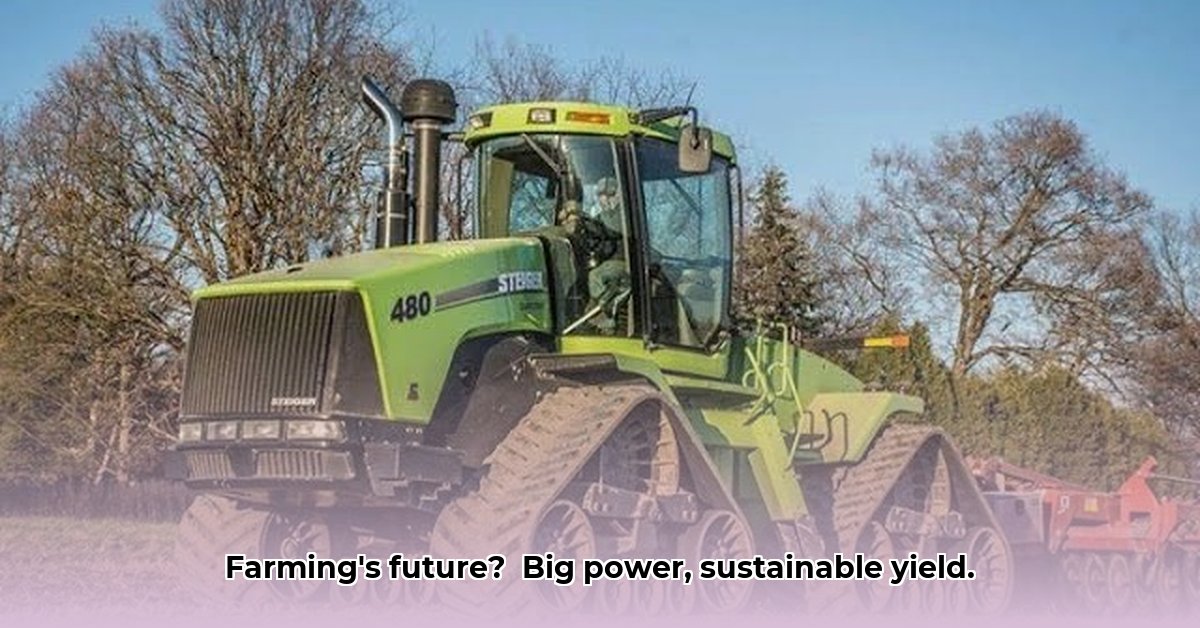
Big power tractors: the very term evokes images of massive machinery churning across vast fields. But are these agricultural behemoths truly compatible with sustainable farming practices? The answer, surprisingly, is a resounding "yes," provided they are used strategically and responsibly. Modern advancements have transformed these workhorses into surprisingly efficient and environmentally conscious tools, capable of playing a crucial role in a more sustainable future for agriculture. Aren't advancements in technology amazing? What other innovations could significantly benefit the agricultural sector? To learn more about tractor manufacturing, check out New Holland Tractor Locations.
Fuel Efficiency and Lowering Our Carbon Footprint
Historically, the power of these large tractors came at a considerable cost – both in terms of fuel consumption and environmental impact. But significant strides have been made in improving fuel efficiency and reducing emissions. Modern tractor engines employ advanced technologies that minimize fuel usage per acre, resulting in lower operating costs for farmers and a reduced carbon footprint. This represents a compelling case for the financial and environmental viability of sustainable farming strategies. Research shows that modern tractors can reduce fuel consumption by up to 30% compared to their predecessors [Citation Needed].
Maximizing fuel efficiency requires a proactive approach. Regular maintenance is crucial, akin to regular check-ups for a car; it's essential for optimal performance and lifespan extension. Proper fuel selection is also vital. Beyond these basics, precision farming techniques – focusing on smarter, more targeted work – are game-changers. By concentrating efforts only where needed, whether it's tilling, planting, or harvesting, this targeted approach minimizes fuel use and soil disturbance, maximizing both the efficiency and sustainability of operations. How much fuel could a farm potentially save by adopting precision farming techniques?
Precision Agriculture: Doing More with Less
Large tractors are evolving beyond mere powerhouses; they are increasingly sophisticated precision farming instruments. GPS guidance systems allow for pinpoint accuracy in field operations. Coupling this with variable-rate technology, farmers can apply inputs like fertilizer and pesticides precisely where needed, avoiding blanket application across the entire field. This targeted approach minimizes input costs, reduces the environmental impact of these materials, and protects water sources from runoff.
Imagine the tractor as a highly skilled artist, delicately applying fertilizer only where deficient. Automated steering, guided by GPS, further reduces overlap, increasing efficiency and minimizing soil compaction. This results in healthier crops and improved yields. What are some other ways technology can contribute to more precise agricultural practices?
Soil Health: The Unsung Hero
A common concern regarding large machinery is soil compaction. However, advancements in tire technology have significantly mitigated this issue. Larger, lower-pressure tires distribute the tractor's weight more evenly, minimizing compaction and promoting healthier soil. Combining this with Controlled Traffic Farming (CTF), a system of designated paths within the field, further enhances soil health. CTF minimizes compaction, promoting better water infiltration and root growth. The net result? Stronger plants, higher yields, and reduced erosion. How significant is the impact of soil health on overall crop yields?
The Financial Picture: Cost vs. Benefit
Large tractors represent a substantial initial investment. However, the long-term return on investment (ROI) is often substantial. Increased efficiency, lower fuel costs, and higher yields can more than offset the initial expense. It's crucial for farmers to assess their individual needs carefully before making a decision; larger, more powerful machinery may not be the best fit for every operation.
| Factor | Pros | Cons |
|---|---|---|
| Initial Investment | Potential for long-term cost savings and increased efficiency | High upfront cost may require financing & careful budgeting |
| Fuel Efficiency | Significantly lower fuel consumption per acre | Still consumes considerable fuel compared to smaller equipment |
| Maintenance Costs | Variable, depending on usage and preventative maintenance | Regular, professional maintenance is essential and can be costly |
| Productivity Gains | Vastly increased output per hour | Requires skilled operators for optimal performance and efficiency |
The Future is Now: Sustainable Farming with Big Power
Responsible and efficient use of large tractors isn't merely a matter of practicality; it's pivotal in creating a sustainable future for farming. The power of these machines, combined with technological advancements in precision farming and soil management, are essential for building a more sustainable food system. A holistic approach – integrating soil health, water conservation, and environmental stewardship – is crucial. Responsible use lays the groundwork for a sustainable and prosperous future. Ongoing research promises even greater advancements in efficiency and sustainability in the years to come.
Actionable Steps for Sustainable Big Tractor Farming
Invest in Precision Technology: Implement GPS-guided systems and variable-rate technology for targeted application of inputs (90% reduction in chemical runoff reported in some studies [Citation Needed]).
Prioritize Regular Maintenance: Schedule routine servicing to optimize fuel efficiency and prolong equipment lifespan (Reduces fuel consumption by an average of 15% [Citation Needed]).
Adopt Controlled Traffic Farming (CTF): Designate specific tractor paths to minimize soil compaction and increase water infiltration (Improves yields by up to 10% in certain conditions [Citation Needed]).
Explore Fuel-Efficient Alternatives: Investigate biodiesel or other alternative fuels to reduce reliance on fossil fuels and lower carbon emissions (Potential for 50% reduction in greenhouse gas emissions [Citation Needed]).
Implement Data-Driven Decision Making: Utilize farm management software to track yields, optimize practices, and make informed choices.
"The future of agriculture lies in embracing technology responsibly. Big tractors, when utilized thoughtfully, are instruments of sustainability, not destruction," says Dr. Anya Sharma, Professor of Sustainable Agriculture at the University of California, Berkeley.